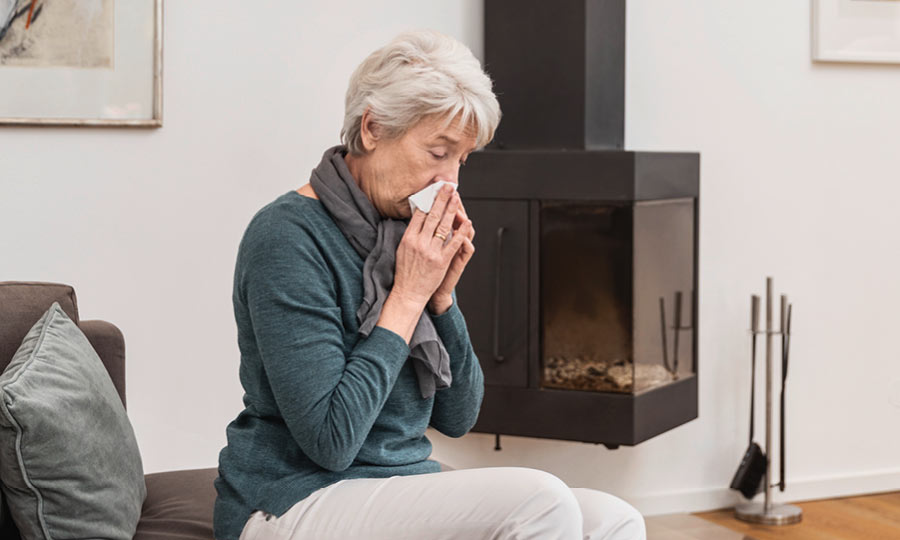So, what is a common cold? Find out more in this report why a common cold is only indirectly related with cold temperatures and why there is no such thing as “a cold”. Also find out what you can do to protect yourself from colds and how to shake them off quickly.
Many of us have heard the advice: “Wear something warm so you don’t catch a cold!”. But is a cold actually caused by the cold or is that just another one of these myths?
A cold is not caused by the cold, but usually by viruses. Why are we more often ill during the cold months of the year? Even if the cold temperature does not cause colds, there are two reasons why colds tend to do the rounds in the autumn and winter.
The cold affects the immune system
The upper airways are where viral respiratory infections gain their first foothold in the body. A study from 2022 shows that cold air can weaken the immune defences of the mucous membranes in our nose.

Dry air affects the self-clearing mechanism of our mucous membranes
Our airways have a clever self-defence mechanism – mucociliary clearance. This is the first line of defence our airways have against pathogens. Dry (central heating) air dries out our mucous membranes and impairs this self-defence mechanism. We should therefore keep our mucous membranes moist, for example by inhaling saline solution.
There are many viruses that can trigger colds. Some of these are rhinoviruses, human coronaviruses, RSV (respiratory syncytial virus) and adenoviruses. It is important to note that RSV can be serious and sometimes life-threatening, especially in babies, toddlers and in the elderly.
Typical symptoms of a cold are:
Depending on the pathogen and the progression of a cold, it may also cause fatigue, headache and sore joints and a mild fever.
How can you distinguish between genuine flu, RSV or COVID-19?
Initially, the symptoms of an RSV infection are virtually indistinguishable from a common cold (sniffly nose, non-productive cough and possibly also a sore throat). Within 1–3 days the infection can then move to the lungs. Usually, the cough is then more pronounced and productive, breathing rate accelerates and the patient can become short of breath. Children will often run a fever, even with a mild course of the disease. In infants and toddlers up to the age of two, there is the risk of bronchiolitis or pneumonia.
Genuine influenza (flu) usually starts suddenly with a fever and feeling very unwell. Headache, muscle pain and/or joint pain are also typical of genuine flu. However, in some people, the flu may be just like a normal cold.
COVID-19 can also vary greatly from one person to another. Often the symptoms resemble those of a cold, especially in vaccinated patients or those who have already recovered from a previous COVID-19 infection. The previously typical loss of smell and taste tends to be rare in the latest variants of the virus.
This means it is often not possible to distinguish between flu, a cold, COVID-19 and RSV based on symptoms alone. If you notice symptoms, ideally avoid contact with other people, and in particular with vulnerable groups. What may be a harmless cold for you may be much more serious in someone else. These vulnerable groups include the elderly, children up to the age of 2 years and generally people with a weakened immune system.
Looking at the large number of different pathogens, you can already see that it is not unusual to have several colds a year. Actually, two to four infections a year is quite normal for adults. Children up to the age of ten years go through about six to eight infections a year.
How can you protect yourself and others? Firstly, it is important to keep your distance from people with visible symptoms of a cold. If you are ill yourself, it is best to stay at home. Regularly airing your home can also reduce the concentration of viruses inside the home. You can also wear a mask.
As shown above, dry and cold air makes the mucous membranes in our airways more susceptible to viruses. Inhalation with isotonic saline solution can support the protection mechanism of our airways and so help us prevent colds.

A cold can, in some cases, trigger acute bronchitis, which announces its presence with a persistent cough with generally thick mucus. If the cold does not migrate to the lungs but rather to the sinuses, this may lead to sinusitis. More rarely, a bacterial superinfection that has to be treated with antibiotics can also follow in the wake of a cold. Signs of a superinfection may be secretions from the nose that have greenish-yellow colour, or greenish phlegm when you cough. If you suspect you have a superinfection, please see your doctor.
There is a saying that goes: It takes a week to get over a cold if you see your doctor, or seven days if you don’t. There is a kernel of truth here: providing you rest, you will usually have no further symptoms after a week. However, there are treatments that can ease symptoms such as a cough, sniffly nose or sore throat.
A nasal rinse with saline solution can support the mucous membranes in the nose to fight of viruses and can ease a sniffly nose. You should ideally start with nasal rinses at the first symptoms of a cold.
You should start inhaling saline solution at the first signs of a cold. Inhalation therapy moistens the mucous membranes in the airways and can ease symptoms such as a cough, mucus build-up, hoarseness or a sore throat. Read more about inhalation therapy for common colds here.
A cold is not caused by cold weather but by viruses. Cold weather and dry air can, however, make us more susceptible. It is not always possible to distinguish clearly between flu, RSV or COVID-19. Please therefore keep your distance from vulnerable groups such as newborn infants, the elderly or people with a weakened immune system if you feel you have a cold. Keeping our airways moist, e.g. by inhaling saline solution, can help prevent colds or ease the symptoms.
Contact us
Any questions? You can reach our service center at this number:
+49 8151 279-5220
© 2025 PARI GmbH Spezialisten für effektive Inhalation